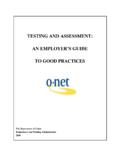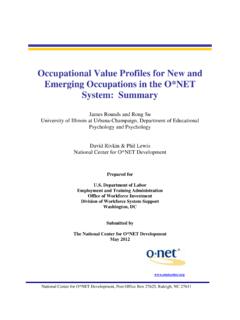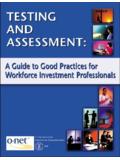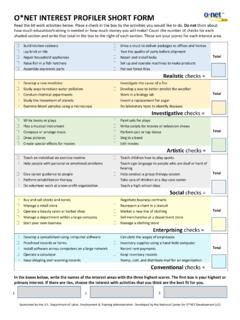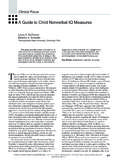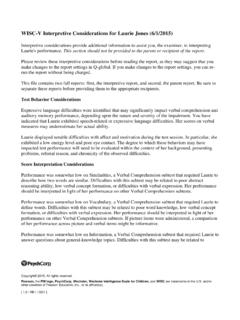Transcription of The O*NET Content Model
1 Prepared by the National Center for O*NET Development for USDOL Page 1 of 33 The O*NET Content Model Detailed Outline with Descriptions The Content Model is the conceptual foundation of O*NET . The Content Model provides a framework that identifies the most important types of information about work and integrates them into a theoretically and empirically sound system. The Content Model was developed using research on job and organizational analysis. It embodies a view that reflects the character of occupations (via job-oriented descriptors) and people (via worker-oriented descriptors). The Content Model also allows occupational information to be applied across jobs, sectors, or industries (cross-occupational descriptors) and within occupations (occupational-specific descriptors). These descriptors are organized into six major domains, which enable the user to focus on areas of information that specify the key attributes and characteristics of workers and occupations.
2 Worker Characteristics enduring characteristics that may influence both work performance and the capacity to acquire knowledge and skills required for effective work performance. Worker characteristics comprise enduring qualities of individuals that may influence how they approach tasks and how they acquire work-relevant knowledge and skills. Traditionally, analyzing abilities has been the most common technique for comparing jobs in terms of worker characteristics. However, recent research supports the inclusion of other types of worker characteristics. In particular, interests, values, and work styles have received support in the organizational literature. Interests and values reflect preferences for work environments and outcomes. Work style variables represent typical procedural differences in the way work is *NET Content Model Worker Characteristics Prepared by the National Center for O*NET Development for USDOL Page 2 of 33 abilities Enduring attributes of the individual that influence performance Cognitive abilities abilities that influence the acquisition and application of knowledge in problem solving Verbal abilities abilities that influence the acquisition and application of verbal information in problem solving Oral Comprehension The ability to listen to and understand information and ideas presented through spoken words and sentences.
3 Written Comprehension The ability to read and understand information and ideas presented in writing. Oral Expression The ability to communicate information and ideas in speaking so others will understand. Written Expression The ability to communicate information and ideas in writing so others will understand. Idea Generation and Reasoning abilities abilities that influence the application and manipulation of information in problem solving Fluency of Ideas The ability to come up with a number of ideas about a topic (the number of ideas is important, not their quality, correctness, or creativity). Originality The ability to come up with unusual or clever ideas about a given topic or situation, or to develop creative ways to solve a problem. Problem Sensitivity The ability to tell when something is wrong or is likely to go wrong. It does not involve solving the problem, only recognizing there is a problem.
4 Deductive Reasoning The ability to apply general rules to specific problems to produce answers that make sense. Inductive Reasoning The ability to combine pieces of information to form general rules or conclusions (includes finding a relationship among seemingly unrelated events). Information Ordering The ability to arrange things or actions in a certain order or pattern according to a specific rule or set of rules ( , patterns of numbers, letters, words, pictures, mathematical operations). Category Flexibility The ability to generate or use different sets of rules for combining or grouping things in different ways. Quantitative abilities abilities that influence the solution of problems involving mathematical relationships Mathematical Reasoning The ability to choose the right mathematical methods or formulas to solve a problem. Number Facility The ability to add, subtract, multiply, or divide quickly and correctly.
5 Memory abilities related to the recall of available information Memorization The ability to remember information such as words, numbers, pictures, and procedures. Perceptual abilities abilities related to the acquisition and organization of visual information Speed of Closure The ability to quickly make sense of, combine, and organize information into meaningful patterns. Flexibility of Closure The ability to identify or detect a known pattern (a figure, object, word, or sound) that is hidden in other distracting material. O*NET Content Model Worker Characteristics Prepared by the National Center for O*NET Development for USDOL Page 3 of 33 Perceptual Speed The ability to quickly and accurately compare similarities and differences among sets of letters, numbers, objects, pictures, or patterns. The things to be compared may be presented at the same time or one after the other.
6 This ability also includes comparing a presented object with a remembered object. Spatial abilities abilities related to the manipulation and organization of spatial information Spatial Orientation The ability to know your location in relation to the environment or to know where other objects are in relation to you. Visualization The ability to imagine how something will look after it is moved around or when its parts are moved or rearranged. Attentiveness abilities related to application of attention Selective Attention The ability to concentrate on a task over a period of time without being distracted. Time Sharing The ability to shift back and forth between two or more activities or sources of information (such as speech, sounds, touch, or other sources). Psychomotor abilities abilities that influence the capacity to manipulate and control objects Fine Manipulative abilities abilities related to the manipulation of objects Arm-Hand Steadiness The ability to keep your hand and arm steady while moving your arm or while holding your arm and hand in one position.
7 Manual Dexterity The ability to quickly move your hand, your hand together with your arm, or your two hands to grasp, manipulate, or assemble objects. Finger Dexterity The ability to make precisely coordinated movements of the fingers of one or both hands to grasp, manipulate, or assemble very small objects. Control Movement abilities abilities related to the control and manipulation of objects in time and space Control Precision The ability to quickly and repeatedly adjust the controls of a machine or a vehicle to exact positions. Multilimb Coordination The ability to coordinate two or more limbs (for example, two arms, two legs, or one leg and one arm) while sitting, standing, or lying down. It does not involve performing the activities while the whole body is in motion. Response Orientation The ability to choose quickly between two or more movements in response to two or more different signals (lights, sounds, pictures).
8 It includes the speed with which the correct response is started with the hand, foot, or other body part. Rate Control The ability to time your movements or the movement of a piece of equipment in anticipation of changes in the speed and/or direction of a moving object or scene. Reaction Time and Speed abilities abilities related to speed of manipulation of objects Reaction Time The ability to quickly respond (with the hand, finger, or foot) to a signal (sound, light, picture) when it appears. O*NET Content Model Worker Characteristics Prepared by the National Center for O*NET Development for USDOL Page 4 of 33 Wrist-Finger Speed The ability to make fast, simple, repeated movements of the fingers, hands, and wrists. Speed of Limb Movement The ability to quickly move the arms and legs. Physical abilities abilities that influence strength, endurance, flexibility, balance and coordination Physical Strength abilities abilities related to the capacity to exert force Static Strength The ability to exert maximum muscle force to lift, push, pull, or carry objects.
9 Explosive Strength The ability to use short bursts of muscle force to propel oneself (as in jumping or sprinting), or to throw an object. Dynamic Strength The ability to exert muscle force repeatedly or continuously over time. This involves muscular endurance and resistance to muscle fatigue. Trunk Strength The ability to use your abdominal and lower back muscles to support part of the body repeatedly or continuously over time without 'giving out' or fatiguing. Endurance The ability to exert oneself physically over long periods without getting out of breath Stamina The ability to exert yourself physically over long periods of time without getting winded or out of breath. Flexibility, Balance, and Coordination abilities related to the control of gross body movements Extent Flexibility The ability to bend, stretch, twist, or reach with your body, arms, and/or legs.
10 Dynamic Flexibility The ability to quickly and repeatedly bend, stretch, twist, or reach out with your body, arms, and/or legs. Gross Body Coordination The ability to coordinate the movement of your arms, legs, and torso together when the whole body is in motion. Gross Body Equilibrium The ability to keep or regain your body balance or stay upright when in an unstable position. Sensory abilities abilities that influence visual, auditory and speech perception Visual abilities abilities related to visual sensory input Near Vision The ability to see details at close range (within a few feet of the observer). Far Vision The ability to see details at a distance. Visual Color Discrimination The ability to match or detect differences between colors, including shades of color and brightness. Night Vision The ability to see under low light conditions.
